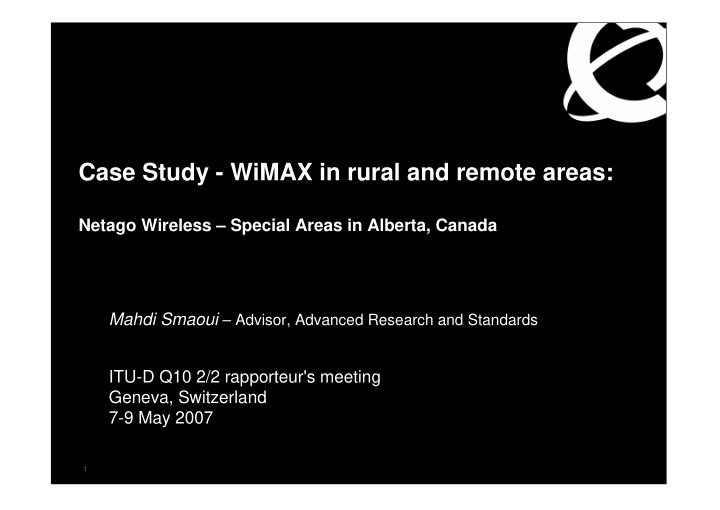



Case Study - WiMAX in rural and remote areas: Netago Wireless – Special Areas in Alberta, Canada Mahdi Smaoui – Advisor, Advanced Research and Standards ITU-D Q10 2/2 rapporteur's meeting Geneva, Switzerland 7-9 May 2007 1
Items covered in this presentation • Introduction • Main drivers of the project • Location and population of the Special Areas • The Special Areas Board • Background on Netago Wireless • Why Netago chose WiMAX? • Nortel’s involvement • Success Story 2
Introduction • This presentation describes a WiMAX trial of a solution in south eastern Alberta in an area called Special Areas of Canada • The area is administered by the Special Areas Board or SAB • WiMAX is a leading technology for providing high speed access to sparsely populated rural areas • WiMAX brings the benefits of DSL-like speeds similar to urban areas to rural and remote areas and enables access to the internet • Nortel provided a trial deployment of WiMAX for Netago Wireless in the Area • This trial demonstrated how WiMAX can successfully provide service to a large, remote area that would otherwise be un- served or, at best, significantly underserved. 3
Main drivers of the project • The population is growing across Alberta except in the Special Areas. The aim is to attract new businesses and families to SAB, retain future generations • Provide high-speed data services to residents of rural Alberta at comparable prices to urban areas • Nortel objective was to supply the customer with the best WiMAX technology and expertise to deliver a cost-efficient fixed broadband solution Broadband services is a missing critical economic driver 4
Location and population of Special Areas • Special Areas are in the province of Alberta, Canada 5
Location and population of Special Areas – cont. • Population in the area is around 12,000 • Area is approximately 21000 square km • Arid terrain • Industries: farming, ranching, oil and gas 6
Location and population of Special Areas – cont. • SAB is a unique rural municipal area covering approximately 2.1 million hectares in south-eastern Alberta 7
Special Areas Board (SAB) • SAB is responsible for the administration of all municipal services in the area • SAB is also responsible for public land management with the lease of more than 50% for the purpose of the local economy (e.g. oil and gas development, pastures, grazing for cattle, cultivation of fields etc...) • Role of maintenance and extension of all local roads comprising some 6000 km and growing. • Provides for the maintenance of parks including planting of trees, maintaining grass and park facilities. • Aims for rural stabilization and economic development through a series of partnerships which allow exploration and development of community supported activities 8
� NETAGO Wireless • Internet Service Provider that now provides the Area wit broadband services • 2003: Netago Wireless is created • 2004: Options for broadband connectivity remain cost prohibitive • 2005: Alberta SuperNet launches - fiber connections for all of Alberta Netago establishes partnerships Partnerships are essential • Upstream provider: Alberta to make the impossible SuperNet probable • Municipal government: Special Areas Board • Equipment manufacturer: Nortel • 2006: WiMAX trial and network launch 9
Decision – Making process: Why NETAGO Chose WiMAX? • Extend existing • Non-proprietary coverage by 50% solution • Economies of scale • Lower cost to consumers • Quality of service • Enable VoIP, prioritize business over end-users WiMAX is THE technology to make broadband happen for this area 10
Nortel involvement in the project • Timing “Nortel's product achieved ranges close to 20 km from the base station to the • Summer 2005: RFP requested outdoor end-user equipment and 15 km to the indoor solution. This • Dec 2005: Equipment arrives exceeded our expectations. And • Jan 2006: Trial launched being such a small company, we really appreciate the relationship we've established with Nortel.” • Implementation: Terry Duchcherer, president and • Cover Hanna and 2 rural areas founder, Netago Wireless • Network operates in the 3.5 GHz band • Trial began with 3 towers/3 Base Transceiver Stations (BTS) • Omni directional antennas • 35 outdoor and 8 indoor subscriber units • Results: • Ranges up to 20 km and 15 km to outdoor and indoor units • Speeds of 1.5 / 2 and 3 Mbps, depending on the needs • Tested streaming video at 8 Mpbs 11
Success Story: Some enabled services and applications • Residents: office from home, online banking, distance learning • Ranchers: agricultural research, buy/sell cattle • Oil company: company LAN speeds of 2 Mpbs increased work productivity • Calgary Stampede: 2 Mpbs Customers are delighted enables transfer of high- bandwidth data 12
Success Story – cont. Coverage at the start of the Netago trial 13
Success Story – cont. Current Coverage by Netago Wireless 14
References and more information • SAB: http://www.specialareas.ab.ca • Netago Wireless: http://www.netago.ca • Nortel Netago Case Study: http://www2.nortel.com/go/news_detail.jsp?cat_id=- 9252&oid=100198324&locale=en-US • Nortel WiMAX solutions : http://products.nortel.com/go/solution_content.jsp?segId=0&p arId=0&prod_id=56600&locale=en-US • Alberta Super Net: http://www.albertasupernet.ca 15
Recommend
More recommend